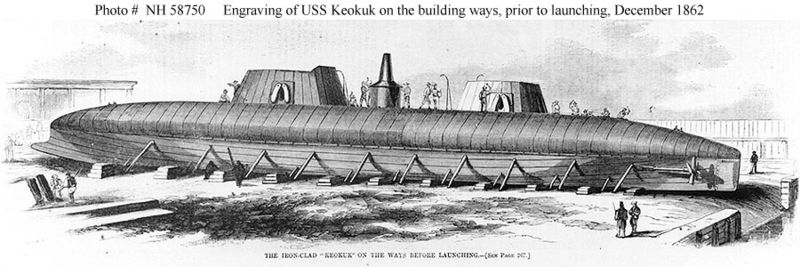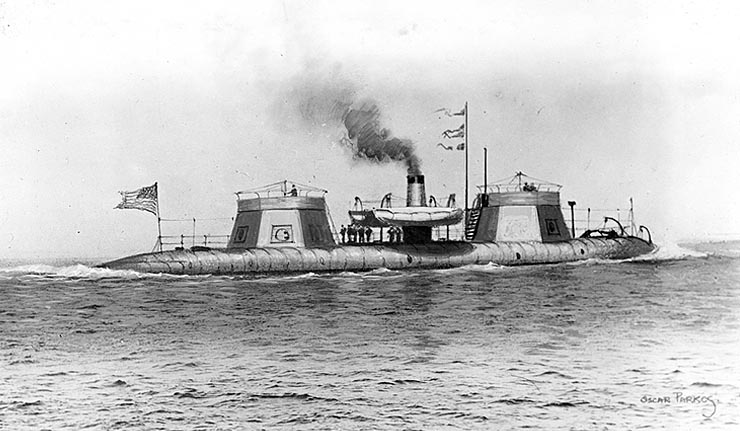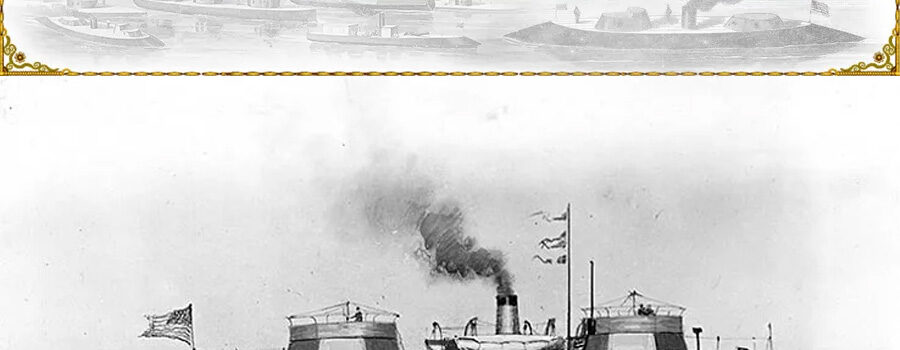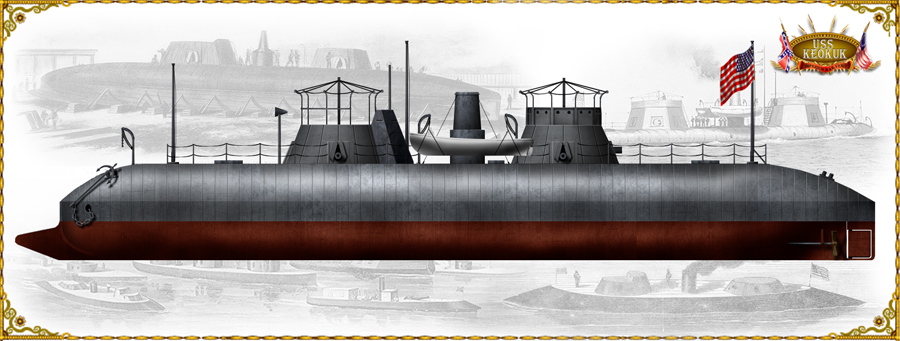 Union Navy
Union Navy
A turtleback Union Turret Ironclad Ram
The Union warship known as Keokuk was born USS Moodna, built on purpose as an experimental ironclad, with several innovative features. She was designed by engineer Charles W. Whitney for New York City’s J.S. Underhill Shipyards, 11th Street. She was named after the eponym city in Iowa and launched on 6 December 1862, with one of the shortest active life or any USN vessel to date.
The Keokuk was the first US warship to be almost entirely built of iron, as wood only apply to deck planking and to fill the armor cladding support. The hull comprised five iron box keelsons and the armor was made of 100 iron frames, one by four feets thick spaced 18in between centers, alternated with yellow pine slats.
The hull was then covered by 1/2 in armour plates, for a total side thickness of 5.75 in (156mm). The decks comprised integral iron cross beams with no transverse planking. Although the ship was quite wide, the bridge itself, due to the sloped sides, was narrow. The bow and stern section were water ballasts which could be flooded to lower the waterline and present the slopest angle to enemy fire -the water itself was seen as an excellent protection below the waterline.

USS Keokuk in construction (no source information) (cc)
The ship was 160ft x 36ft x 8ft6 (48.6 x 11 x 2.6m), with a 688 short tons dispacement. It was propelled by two shafts, actioned by two 2-cylinder 250hp steam engines, and could reach 9 knots at full speed. There were nine auxiliary steam engines for various electrical systems on board.
The armament comprised two eight-face turrets pierced by multiple ports, each with a single 11-in Dahlgren rifled guns, and the reinforced ram.
The USS Keokuk was accepted in service in march 1863, with Commander Alexander C. Rhind as commander and a crew of 92 officers and men. First assignation was the South Atlantic Blockading Squadron.
She was due to participate in the attack of Charleston. But en route, on march, 17, one of her propeller was fouled in an anchor buoy line, and she has to be repaired at Hampton roads. On the 26, she steamed to port Royal, then took part in laying buoys with USS Bibb, to guide the approaches to Charleston for Admiral Francis DuPont fleet of 11 ironclads.
The attack was postponed due to bad weather, and renewed on April, 7. But the operation was a near fiasco and few progresses were made due to torpedoes and other Southern obstructions, until the fleet was in reach of Fort Moultrie and Fort Sumter. Then, other obstructions combined to a very high tide made the ships unmanageable, while being sitting ducks for the fort’s accurate fire.
The Keokuk, to avoid collision with the USS Nahant, almost ran aground at only 600 yards (550m) of Fort Sumter. For half an hour, she was pounded at point-blank range, hit ninety times, hopefully attracting the gunners attention while other ships could disengage. The underwater protection was quickly proven insufficient after been hit several times, and the ship was flooded. Eventually USS Keokuk was able to disengage and leave “completely riddled”, thanks to the skills of the pilot, Robert Small.
The crew managed to keep her afloat until the next day, when a breeze aggravated the flooding, and the ship listed and finally sank off Morris Island, slowly enough to be evacuated. 14 men of the crew were wounded, including Captain Rhind and the quartermaster Robert Anderson (later awarded the Medal of Honor). Gunnery Ensign Mackintosh was the only man to die later from his wounds.

USS Keokuk at sea, Courtesy of Dr. Oscar Parkes, London, England, 1936. United States Naval History and Heritage Command. (cc)
Later on, a federal survey concluded that the ship, filled with sand, was unable to be refloated and it was decided to left the wreck there. CSS officer P.G.T. Beauregard however mounted a salvage operation for retrieving the two precious Dahlgren guns. The operation led by civil engineer Adolphus W. LaCoste was performed at night, at low tide, under the protection of the CSS Palmetto State and Chicora. The guns were later mounted ashore and active until the end of the war.



 Latest Facebook Entry -
Latest Facebook Entry -  X(Tweeter) Naval Encyclopedia's deck archive
X(Tweeter) Naval Encyclopedia's deck archive Instagram (@navalencyc)
Instagram (@navalencyc)





 French Navy
French Navy Royal Navy
Royal Navy Russian Navy
Russian Navy Armada Espanola
Armada Espanola Austrian Navy
Austrian Navy K.u.K. Kriegsmarine
K.u.K. Kriegsmarine Dansk Marine
Dansk Marine Nautiko Hellenon
Nautiko Hellenon Koninklije Marine 1870
Koninklije Marine 1870 Marinha do Brasil
Marinha do Brasil Osmanlı Donanması
Osmanlı Donanması Marina Do Peru
Marina Do Peru Marinha do Portugal
Marinha do Portugal Regia Marina 1870
Regia Marina 1870 Nihhon Kaigun 1870
Nihhon Kaigun 1870 Preußische Marine 1870
Preußische Marine 1870 Russkiy Flot 1870
Russkiy Flot 1870 Svenska marinen
Svenska marinen Søværnet
Søværnet Union Navy
Union Navy Confederate Navy
Confederate Navy Armada de Argentina
Armada de Argentina Imperial Chinese Navy
Imperial Chinese Navy Marinha do Portugal
Marinha do Portugal Mexico
Mexico Kaiserliche Marine
Kaiserliche Marine 1898 US Navy
1898 US Navy Sovietskiy Flot
Sovietskiy Flot Royal Canadian Navy
Royal Canadian Navy Royal Australian Navy
Royal Australian Navy RNZN Fleet
RNZN Fleet Chinese Navy 1937
Chinese Navy 1937 Kriegsmarine
Kriegsmarine Chilean Navy
Chilean Navy Danish Navy
Danish Navy Finnish Navy
Finnish Navy Hellenic Navy
Hellenic Navy Polish Navy
Polish Navy Romanian Navy
Romanian Navy Turkish Navy
Turkish Navy Royal Yugoslav Navy
Royal Yugoslav Navy Royal Thai Navy
Royal Thai Navy Minor Navies
Minor Navies Albania
Albania Austria
Austria Belgium
Belgium Columbia
Columbia Costa Rica
Costa Rica Cuba
Cuba Czechoslovakia
Czechoslovakia Dominican Republic
Dominican Republic Haiti
Haiti Hungary
Hungary Honduras
Honduras Estonia
Estonia Iceland
Iceland Eire
Eire Equador
Equador Iran
Iran Iraq
Iraq Latvia
Latvia Liberia
Liberia Lithuania
Lithuania Mandchukuo
Mandchukuo Morocco
Morocco Nicaragua
Nicaragua Persia
Persia San Salvador
San Salvador Sarawak
Sarawak Uruguay
Uruguay Venezuela
Venezuela Zanzibar
Zanzibar Warsaw Pact Navies
Warsaw Pact Navies Bulgaria
Bulgaria Hungary
Hungary

 Bundesmarine
Bundesmarine Dutch Navy
Dutch Navy Hellenic Navy
Hellenic Navy Marina Militare
Marina Militare Yugoslav Navy
Yugoslav Navy Chinese Navy
Chinese Navy Indian Navy
Indian Navy Indonesian Navy
Indonesian Navy JMSDF
JMSDF North Korean Navy
North Korean Navy Pakistani Navy
Pakistani Navy Philippines Navy
Philippines Navy ROKN
ROKN Rep. of Singapore Navy
Rep. of Singapore Navy Taiwanese Navy
Taiwanese Navy IDF Navy
IDF Navy Saudi Navy
Saudi Navy Royal New Zealand Navy
Royal New Zealand Navy Egyptian Navy
Egyptian Navy South African Navy
South African Navy






























 Ukrainian Navy
Ukrainian Navy dbodesign
dbodesign